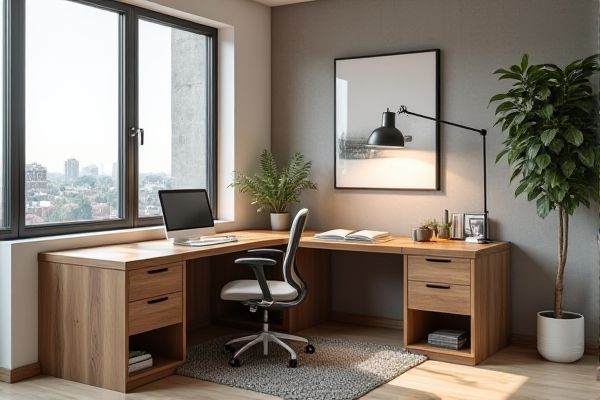
Corner desks maximize space by fitting snugly into room corners, ideal for small areas and multitasking, while L-shaped desks provide a larger surface area often favored for having distinct work zones or shared usage. Explore the detailed benefits and drawbacks of each to determine which desk best supports your productivity and workspace needs.
Table of Comparison
| Feature | Corner Desk | L-Shaped Desk |
|---|---|---|
| Design | Fits snugly into room corners, typically a single continuous surface | Consists of two connected surfaces forming an "L", often larger workspace |
| Space Utilization | Maximizes small corner spaces, ideal for limited rooms | Requires more room, uses two walls or extends out from a corner |
| Workspace Area | Smaller surface, suitable for minimalist setups | Larger surface area, supports multiple monitors and accessories |
| Ergonomics | Compact layout with limited movement | Encourages better organization with distinct work zones |
| Assembly & Installation | Generally easy to set up, fewer parts | May require more complex assembly due to multiple sections |
| Cost | Usually more affordable due to simple design | Tends to be costlier with larger size and features |
| Best Use | Small home offices, compact workspaces | Professional offices, multitasking setups, larger rooms |
Introduction to Corner Desks and L-Shaped Desks
Corner desks are designed to fit snugly into a room's corner, maximizing space efficiency and providing a compact yet functional workspace ideal for small areas. L-shaped desks consist of two connected rectangular work surfaces forming a right angle, offering expansive tabletop space that supports multitasking and accommodates multiple monitors or office equipment. Both desk types enhance productivity by optimizing room layout and ergonomic comfort in home offices or professional settings.
Key Design Differences
Corner desks are designed to fit snugly into room corners, maximizing space by utilizing two adjoining walls, while L-shaped desks form a distinct two-part workspace with one longer and one shorter section often placed perpendicularly. The key design difference lies in the spatial footprint and modularity, as corner desks typically have a more fixed shape, whereas L-shaped desks offer greater flexibility for customization and rearrangement. Your choice depends on how much surface area you need and the room layout, with corner desks ideal for compact setups and L-shaped desks better suited for multitasking or dual-use zones.
Space Utilization and Room Fit
Corner desks maximize space utilization by fitting snugly into room corners, ideal for small or irregularly shaped rooms, creating an efficient workstation without interrupting room flow. L-shaped desks offer versatile room fit with extended surface areas along two adjoining walls, accommodating multiple monitors or work zones, making them perfect for larger offices or home workspaces. Both designs optimize functionality, but corner desks excel in compact spaces, while L-shaped desks provide expansive layouts for multitasking.
Functionality and Workflow
Corner desks maximize office space by fitting snugly into room angles, providing an efficient workstation with easy access to multiple surfaces, ideal for multitasking. L-shaped desks offer a distinct separation between work zones, enhancing workflow organization by allocating specific areas for computing and paperwork. Both designs support ergonomic setups, but L-shaped desks may better accommodate dual monitors and additional office equipment, optimizing productivity.
Storage and Organization Options
Corner desks typically offer compact storage solutions ideal for small spaces, featuring built-in shelves or drawers optimized for essentials. L-shaped desks provide more extensive storage and organization options due to their larger surface area and additional compartments, perfect for multitasking and keeping your workspace clutter-free. Choosing between the two depends on your need for storage capacity and how you plan to organize your work materials.
Aesthetic Appeal and Style Choices
Corner desks offer a sleek, space-saving design ideal for minimalist and modern interiors, seamlessly fitting into room corners for a clean, unobtrusive look. L-shaped desks provide more visual presence and versatility, often serving as statement pieces with diverse style options ranging from rustic wood finishes to contemporary metal frames. Both desk types enhance room aesthetics by maximizing workspace while complementing various interior decor themes.
Comfort and Ergonomics
Corner desks provide optimal comfort by fitting snugly into room corners, maximizing space while allowing for efficient arm and wrist positioning to reduce strain. L-shaped desks enhance ergonomics by offering expansive work surfaces that accommodate multiple monitors and peripherals, promoting better posture through strategic placement of equipment. Both designs improve workflow organization and minimize repetitive movements, crucial for maintaining long-term comfort during extended work sessions.
Cost Comparison
Corner desks typically offer a more budget-friendly option compared to L-shaped desks due to their simpler design and smaller size, making them ideal for compact spaces. L-shaped desks usually come at a higher price point because of their larger surface area and additional features, such as extra storage or cable management. When considering cost, buyers should evaluate their workspace needs and budget constraints to determine which desk provides the best value for functionality and space utilization.
Pros and Cons of Corner Desks
Corner desks maximize space by fitting snugly into room corners, making them ideal for small or multi-purpose areas. Their design offers ample surface area while keeping your workspace compact, but limited legroom and accessibility in the corner may pose challenges. Choosing a corner desk depends on your need for space efficiency versus comfort and ease of movement.
Pros and Cons of L-Shaped Desks
L-shaped desks offer ample workspace and can fit neatly into corners, maximizing room efficiency and providing separate zones for tasks, ideal for multitasking and enhanced organization. However, they may require more floor space and can be challenging to position in smaller rooms or irregular layouts. Your choice depends on balancing the need for surface area with available space and room configuration.
 homyna.com
homyna.com